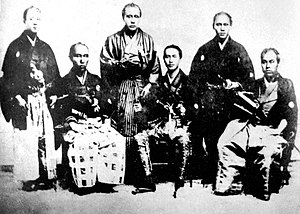Kanrin Maru (咸臨丸) was Japan's first sail and screw-driven steam corvette (the first steam-driven Japanese warship, Kankō Maru, was a side-wheeler). She was ordered in 1853 from the Netherlands, the only Western country with which Japan had diplomatic relations throughout its period of sakoku (seclusion), by the Shogun's government, the Bakufu. She was delivered on September 21, 1857 (with the name Japan) by Lt. Willem Huyssen van Kattendijke of the Dutch navy. The ship was used at the newly established Naval School of Nagasaki in order to build up knowledge of Western warship technology.
Kanrin Maru, as a screw-driven steam warship, represented a new technological advance in warship design which had been introduced in the West only ten years earlier with HMS Rattler (1843). The ship was built by the shipyard of Fop Smit at Kinderdijk in the Netherlands, where the virtually identical screw-steamship with schooner-rig Bali of the Dutch navy was also built in 1856. She allowed Japan to get its first experience with some of the newest advances in ship design.[1]
Japanese embassy to the US[]
Three years later, the Bakufu sent Kanrin Maru on a mission to the United States, clearly wanting to make a point to the world that Japan now mastered western navigation techniques and western ship technologies. On 9 February 1860 (18 January in Japanese calendar), the Kanrin Maru, sailed by Katsu Kaishū (as ship captain), John Manjiro, Fukuzawa Yukichi, altogether 96 Japanese sailors, and the American officer John M. Brooke, left Uraga for San Francisco.
This became the second official Japanese embassy to cross the Pacific Ocean, around 250 years after the embassy of Hasekura Tsunenaga to Mexico and then Europe in 1614, on the Japanese-built galleon San Juan Bautista.
Kanrin Maru was accompanied by a United States Navy ship, the Powhatan.
The official objective of the mission was to send the first ever Japanese embassy to the US, and to ratify the new treaty of Friendship, Commerce, and Navigation between the United States and Japan.
Boshin war[]

Members of the Japanese Embassy to the United States (1860), who sailed on the Kanrin Maru and the USS Powhatan. Fukuzawa Yukichi sits on the right.
By the end of 1867, the Bakufu was attacked by pro-imperial forces, initiating the Boshin War which led to the Meiji Restoration. Towards the end of the conflict, in September 1868, after several defeats by the Bakufu, Kanrin Maru was one of the eight modern ships led by Enomoto Takeaki towards the northern part of Japan, in his final attempt to wage a counter-attack against pro-imperial forces.
The fleet encountered a typhoon on its way northward, and Kanrin Maru, having suffered damage, was forced to take refuge in Shimizu harbour, where she was captured by Imperial forces, who bombarded and boarded the ship notwithstanding a white flag of surrender, and put the skeleton crew aboard to the sword.[2]
Enomoto Takeaki finally made a rendition in May 1869, and after the end of the conflict, Kanrin Maru was used by the new Imperial government for the development of the northern island of Hokkaido.
She was lost there in a typhoon in 1871, at Esashi.
Kanrin Maru today[]
In 1990, a ship replica twice the size of the original was ordered for manufacture in the Netherlands, according to the original plans. The ship was visible in the theme park of Huis Ten Bosch in Kyūshū, in southern Japan. It is now used as a sightseeing ship to the Naruto whirlpools from Minami Awaji harbour.
Notes[]
- ↑ Hendrik Caspar Romberg's account of the Sangoku-maru is a scant record of the brief attempt by the Tokugawa shogunate to create a sea-going vessel in the 1780s. The ship sank; and the tentative project was abandoned when the political climate in Edo shifted. See Timon Screech. (2006). Secret Memoirs of the Shoguns: Isaac Titsingh and Japan, 1779-1822, pp. 48-49., p. 48, at Google Books
- ↑ Oliver Statlet, Japanese Inn, Honolulu: University of Hawaii Press, 1982, p. 274.
References[]
- H. Huygens, "Z.M. schroef-schooner Bali," in: Verhandelingen en berigten betrekkelijk het zeewezen en de zeevaartkunde, vol. 17 (1857), pp. 178–183, esp. p. 182
- "Steam, Steel and Shellfire. The steam warship 1815-1905" Conway's History of the ship ISBN 0-7858-1413-2
- "The origins of Japanese Trade Supremacy. Development and technology in Asia from 1540 to the Pacific War" Christopher Howe, The University of Chicago Press, ISBN 0-226-35485-7
- "End of the Bakufu and the Restoration at Hakodate" (Japanese 函館の幕末・維新) ISBN 4-12-001699-4
External links[]
| ||||||||||||||||||||||||||||||||||||||
The original article can be found at Japanese warship Kanrin Maru and the edit history here.


